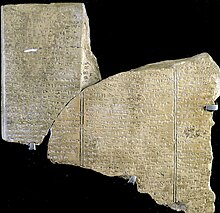
Back النصوص الأوغاريتية Arabic Textos ugarítics Catalan כתבי אוגרית HE Угаритская литература Russian Ugaritska besedila Slovenian Уґаритська література Ukrainian

The Ugaritic texts are a corpus of ancient cuneiform texts discovered in 1928 in Ugarit (Ras Shamra) and Ras Ibn Hani in Syria, and written in Ugaritic, an otherwise unknown Northwest Semitic language. Approximately 1,500 texts and fragments have been found to date. The texts were written in the 13th and 12th centuries BC.
The most famous of the Ugarit texts are the approximately fifty epic poems; the three major literary texts are the Baal Cycle, the Legend of Keret, and the Tale of Aqhat. The other texts include 150 tablets describing the Ugaritic cult and rituals, 100 letters of correspondence, a very small number of legal texts (Akkadian is considered to have been the contemporary language of law), and hundreds of administrative or economic texts.
Unique among the Ugarit texts are the earliest known abecedaries, lists of letters in alphabetic cuneiform, where not only the canonical order of the later Phoenician script is evidenced, but also the traditional names for letters of the alphabet.[2][3][4]
Other tablets found in the same location were written in other cuneiform languages (Sumerian, Hurrian, and Akkadian), as well as Egyptian and Luwian hieroglyphs, and Cypro-Minoan.
- ^ Cite error: The named reference
Demskywas invoked but never defined (see the help page). - ^ Berman, Ruth Aronson (2005-01-24). Perspectives on Language and Language Development: Essays in Honor of Ruth A. Berman. Springer Science & Business Media. ISBN 978-1-4020-7903-0.
- ^ Encyclopedia of Language and Linguistics. Elsevier. 2005-11-24. ISBN 978-0-08-054784-8.
- ^ Caquot, Andre; Sznycer, Maurice (2023-08-14). Ugaritic Religion. BRILL. ISBN 978-90-04-66447-0.